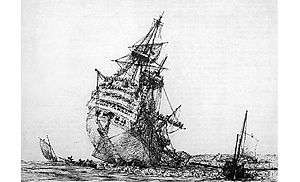French ship Royal Louis (1780)
 Républicain grounded on Mingant rock. Drawing by Pierre Ozanne. | |
| History | |
|---|---|
| Namesake: | Louis of France |
| Builder: | Brest Dockyard |
| Laid down: | 8 March 1779 |
| Launched: | 20 March 1780 |
| Completed: | June 1780 |
| Commissioned: | June 1780 |
| Renamed: | Républicain (29 September 1792) |
| Fate: | wrecked, 24 December 1794 |
| General characteristics | |
| Class and type: | 106-gun ship of the line |
| Tonnage: | 2,400 |
| Displacement: | 4,835 |
| Length: | 186 French feet[1] |
| Beam: | 50 French feet |
| Draught: | 26½ French feet |
| Depth of hold: | 24½ French feet |
| Complement: | 1,035 - 1,150 |
| Armament: | |
| Armour: | timber |
The Royal Louis was a 106-gun (110 guns from 1786) ship of the line of the French Royal Navy. She was designed and built at Brest Dockyard by Léon-Michel Guignace.
She was renamed Républicain in September 1792. Under this name, she took part in the Third Battle of Ushant, being the last ship of the French rear. She was attacked, totally dismasted, and struck her colours; however, the British failed to capture her, and she returned to Rochefort.
On 24 December 1794, she took part in the Croisière du Grand Hiver. As the fleet exited Brest harbour, she ran aground with the loss of 10 men. Her crew abandoned ship, and the wreck was destroyed in a tempest a few days later.
References
- Roche, Jean-Michel (2005). Dictionnaire des bâtiments de la flotte de guerre française de Colbert à nos jours 1 1671 - 1870. p. 223. ISBN 978-2-9525917-0-6. OCLC 165892922.
- Nomenclature des navires français de 1715 á 1774. Alain Demerliac (Editions Omega, Nice – 1995). ISBN 2-906381-19-5.
- Winfield, Rif and Roberts, Stephen (2017) French Warships in the Age of Sail 1626-1786: Design, Construction, Careers and Fates. Seaforth Publishing. ISBN 978-1-4738-9351-1.
- "http://marinepremierempire.free.fr/le_royal_louis__le_republicain__1792__573.htm Page no longer exists, August 2014.
This article is issued from
Wikipedia.
The text is licensed under Creative Commons - Attribution - Sharealike.
Additional terms may apply for the media files.